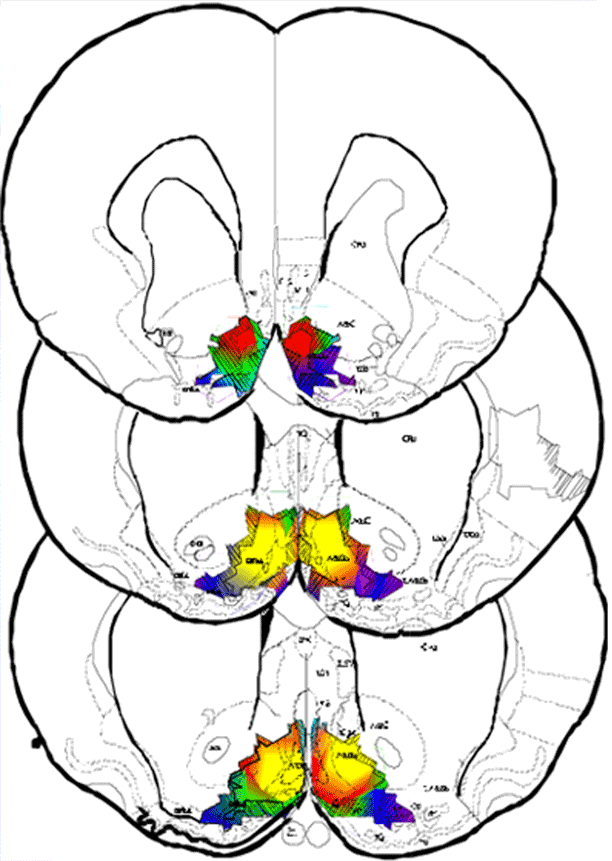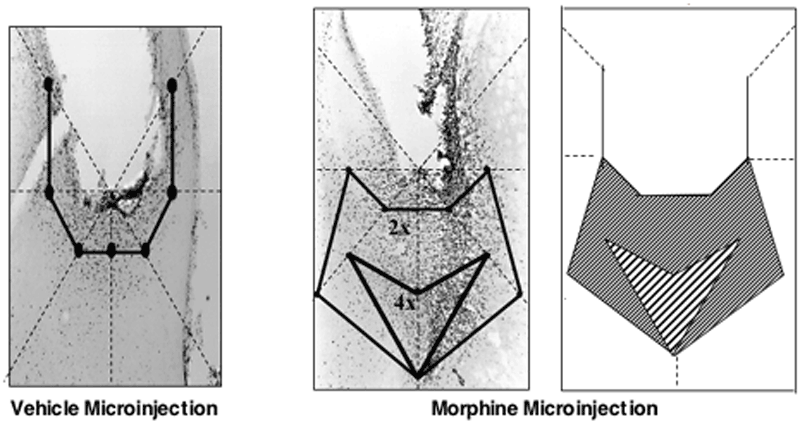Research Ethics & Strategy
Our laboratory exploits the microstructure of natural behavior to discover new truths about brain and psychology, instinctive behavior and affective reactions. Natural affective reactions and instinctive behaviors provide windows into controls of sensory pleasure, fear, or executive action syntax functions. Combined with conventional behavioral neuroscience techniques (instrumental & classical conditioning) and neuroscience techniques for manipulating brain function (painless drug microinjections), we explore how brain systems generate psychological processes.
What is the picture to the right?
Map of enhanced 'liking' in nucleus accumbens caused by opioid microinjections of morphine.
Click image to enlarge.
Research Techniques
Behavioral Microstructure - Much research in our laboratory involves detailed videoanalyses of the microstructure of natural or instinctive behavioral patterns. We are best known for our affective neuroscience studies of brain 'liking' systems using the affective taste reactivity technique.

Taste Reactions
Taste reactivity measures the microstructure of facial affective expressions to taste sensory pleasure, which in rodents, primates, & humans all derive from the same ancestral mechanisms. Similarly, to study the brain bases of action syntax we have developed microstructural measures of syntactic grooming chains.

Rat Grooming Syntax

DAT Knockdown grooming fixed action pattern

Squirrel Groom Displays
We also use conventional rodent instrumental and classical conditioning procedures, place preference tests, and other traditional behavioral neuroscience techniques.
Neuroscience manipulations - We use several neuroscience techniques that selectively and painlessly alter a single neural system in the brain.
Laser activation & inhibition of targeted brain systems. We use optogenetics techniques to painlessly manipulate the brain with light (photo below). A blue laser light delivered via optic fiber to the brain selectively activates a virus-targeted neural system. Specificity is obtained by previously microinjecting a tiny quantity of virus containing RNA instructions for builidng photoreceptor molecules into a brain structure under anesthesia and laser probes are implanted in the brain to selectively activate the cells expressing the virus (adjacent photo depicting a recreation of laser stimulation of the ventral striatum by either a blue (473nm) or red (635nm) laser).


The virus selectively causes a chosen set of neurons to become light sensitive, and open ion channels to stimulate the neurons when the laser is on. Conversely, a differently colored red or other laser light inhibits the neurons via different photoreceptors. These techniques can painlessly control 'wanting' and 'liking' or other emotional processes.


The green photo below shows neurons in the basolateral amygdala (left) and nucleus accumbens (right) making a green fluorescent protein after being infected by virus.


Drug microinjections into brain. To pinpoint sites of brain neurochemical circuits controlling emotion we developed a Fos plume mapping technique to localize function using painless brain microinjections that place drugs into a selected brain region. We also sometimes use histological techniques such as Fos plume maps to measure the neuronal activation caused by microinjected drugs. Finally we have studied how the firing patterns of brain neurons code ‘liking’, ‘wanting’, and action syntax functions in collaborative studies with Prof. J. Wayne Aldridge’s laboratory [Neurology & Psychology].

Click image to enlarge.
What is this?
Fos plumes from drug microinjection. Neurons surrounding microinjection have elevated Fos protein from drug-induced transcription of c-fos gene. Elevated Fos plumes reveals how far a drug spreads to directly activate neurons.
Psychological theory - We aim to better understand fundamental psychological questions. How is pleasure caused in the brain? What is the nature of wanting and liking? How do rewards shape incentive motivation and behavior? How does the brain code the difference between positive affect and negative affect? How does fear relate to desire? What does instinctive behavior have in common with human language? How are complex streams of real behavior produced by a brain? We believe that psychological theory illuminates the meaning of neuroscience data, and that in turn neuroscience studies can be used to develop psychological insights. Our combination of affective neuroscience and biopsychology techniques with appropriate psychological theory helps us find better answers to these fundamental questions.
Ethical testing - We strive for good research ethics in affective neuroscience. Our research uses painless behavioral testing procedures for all our animal subjects, and never involves significant suffering. All neuroscience manipulations (used only for rat and mouse studies) are conducted painlessly or under appropriate anesthesia. Our behavioral tests of reward and pleasure are not painful. Whenever our research collaborations involve human subjects the studies are carried out by experts who specialize in those studies. All research techniques used in the laboratory have been approved by the appropriate ethical review boards within the university and by US federal grant agencies (National Institutes of Health & National Science Foundation).

